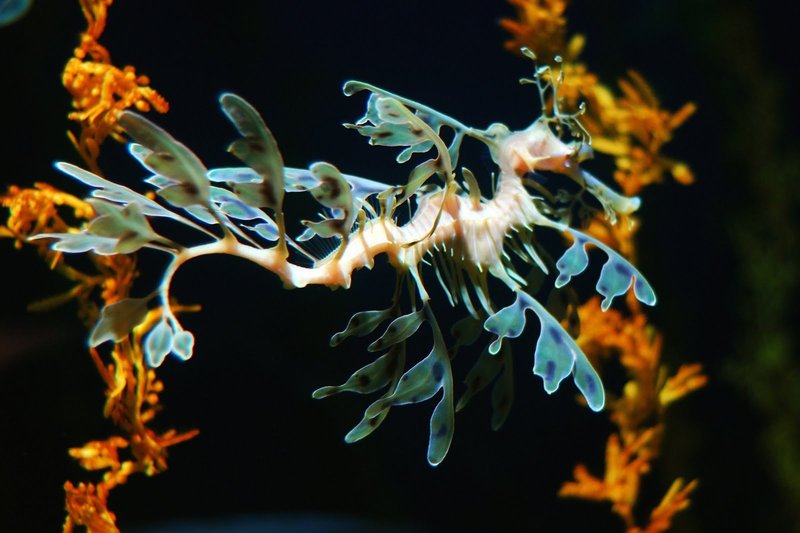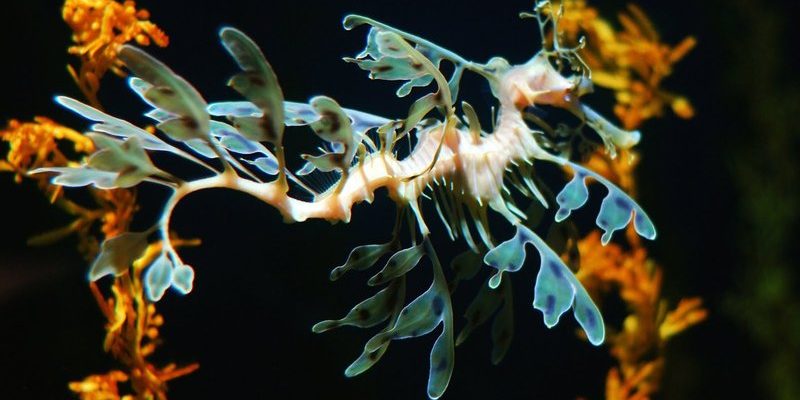
The Leafy Sea Dragon is one of the ocean’s most mesmerizing creatures, almost like something straight out of a fantasy tale. Imagine a tiny dragon gliding through water, adorned with leafy appendages that help it blend seamlessly into its surroundings. Found primarily along the southern coasts of Australia, these remarkable animals are not only beautiful but also play a crucial role in the underwater ecosystem.
When you see a Leafy Sea Dragon, it’s hard not to be captivated by its vibrant colors and delicate features. These fascinating creatures can grow up to 18 inches long, and their unique appearance serves a specific purpose. Much like a master of disguise, the Leafy Sea Dragon uses its leafy appendages to camouflage itself among the kelp and seaweed, evading predators while hunting for food.
Let’s dive into the world of the Leafy Sea Dragon, exploring its habitat, diet, and reproduction, and uncover the wonders of this extraordinary marine animal.
Physical Characteristics
One of the most outstanding features of the Leafy Sea Dragon is, without a doubt, its appearance. Its long, slender body is adorned with numerous leaf-like structures that make it look like a piece of driftwood adorned with greenery. This fascinating design is not just for show; it’s an evolutionary advantage. The leafy structures help these creatures blend into their environment, effectively becoming invisible to both predators and prey. It’s like wearing a cloak of seaweed!
Typically, Leafy Sea Dragons have a mottled coloration of greens, yellows, and browns, which helps them match the colors of their natural habitat. These colors can change slightly based on the surrounding environment or the creature’s mood. Their bodies are covered with bony plates instead of scales, giving them a unique texture that adds to their dragon-like appearance.
Interestingly, the Leafy Sea Dragon does not possess fins like many other fish. Instead, it moves through the water using a small dorsal fin located on its back. This fin is almost invisible when the creature is still, adding to the illusion of a floating piece of seaweed. Their pectoral fins are tiny and located behind their eyes, which allows for delicate, precise movements in the water.
Habitat and Distribution
Leafy Sea Dragons inhabit the cool waters of southern Australia, mainly found along the coasts of South Australia, Victoria, and Tasmania. They prefer shallow waters, often residing close to rocky reefs and seagrass beds. These areas provide the perfect environment for them to hide from predators and feed on their favorite meals, small crustaceans like mysid shrimp.
These creatures are typically found at depths of around 30 feet, where they can easily navigate through kelp forests and seaweed beds. The plants not only offer shelter but also serve as hunting grounds where they can ambush their prey. The leafy appendages that adorn their bodies mimic the shape and movement of the surrounding vegetation, making it challenging for both predators and prey to spot them.
During the breeding season, Leafy Sea Dragons may move into slightly deeper waters, but they always remain close to their preferred habitats. Conservation efforts are essential for protecting these delicate environments, as pollution and habitat destruction can significantly impact their survival.
Diet and Feeding Habits
When it comes to food, Leafy Sea Dragons are not picky eaters, but their diet primarily consists of small crustaceans. Their favorite snacks include mysid shrimp and small marine invertebrates. Since they rely on camouflage to catch their meals, they have developed fascinating feeding techniques that enhance their hunting success.
Using their elongated snouts, Leafy Sea Dragons suck in their prey like a vacuum, providing them with the ideal way to capture small and quick-moving foods. This method allows them to remain relatively still, conserving energy while waiting for a meal to come within reach. The combination of their stealthy appearance and unique feeding strategy makes them adept hunters in their underwater realm.
One intriguing aspect of their feeding habits is their reliance on the availability of food in their environment. They may adjust their feeding times based on the tide and water temperature, which can affect the movement of their prey. This adaptability helps them thrive in the sometimes unpredictable ocean habitat.
Reproduction and Lifecycles
When it comes to reproduction, Leafy Sea Dragons have a unique and somewhat unusual approach. Unlike many fish species, it is the males that bear the young. During the mating process, females will transfer their eggs to the male’s brood pouch located on the underside of his tail. This brood pouch provides a safe space for the developing embryos.
After the female lays her eggs, the male becomes responsible for fertilization and caring for them. The eggs can remain in the pouch for up to six weeks, during which time the male maintains a steady flow of water around the eggs to ensure they get enough oxygen. As the young develop, the male will exhibit a change in color, becoming more vibrant and colorful, highlighting his role as a caring parent.
Once the eggs are ready to hatch, the male Leafy Sea Dragon will release the tiny, fully-formed babies into the water. Each baby is about a half-inch long and is immediately independent. This unique reproductive strategy ensures that the young can start life with minimal dependence on their parents, which is vital in the wild where survival is a challenge.
Conservation Status
The Leafy Sea Dragon is classified as a near-threatened species, which means they face potential risks in their habitats. As a result, conservation efforts are increasingly essential to protect these unique creatures. Habitat destruction, pollution, and climate change pose significant threats to their populations. The vibrant ecosystems they depend on are being altered, primarily due to human activities.
To combat these issues, various initiatives are underway to safeguard the habitats of Leafy Sea Dragons. Marine reserves and protected areas are essential for allowing these creatures to thrive without the pressures of fishing and industrial activities. Engaging local communities in conservation efforts is also crucial as it fosters a sense of responsibility toward protecting marine life.
Education and awareness play a vital role in conservation. By sharing the story of the Leafy Sea Dragon, we can inspire others to take action, whether through reducing plastic use, supporting sustainable practices, or advocating for marine protection policies. Every small step counts in preserving the beauty of these majestic creatures for future generations to admire.
Interesting Facts
| Scientific Name: | Phycodurus eques |
| Size: | Up to 18 inches (45 cm) long |
| Habitat: | Shallow coastal waters, typically in kelp forests |
| Diet: | Small crustaceans like mysid shrimp |
| Lifespan: | Up to 3 years in the wild |
| Coloration: | Green, yellow, and brown hues for camouflage |
FAQ
What does a Leafy Sea Dragon eat?
Leafy Sea Dragons primarily feed on small crustaceans, with mysid shrimp being their favorite snack. They use their elongated snouts to suck in prey, allowing them to catch food without much movement. This method enables them to remain still and conserve energy while waiting for their meals to come closer.
Are Leafy Sea Dragons dangerous?
No, Leafy Sea Dragons are not dangerous. In fact, they are quite shy and primarily evade threats by blending into their surroundings. Their unique camouflage helps them avoid predators, making them fascinating but harmless creatures when encountered in their natural habitat.
How do Leafy Sea Dragons reproduce?
In a unique twist, it is the male Leafy Sea Dragon that carries the eggs. The female transfers her eggs to the male’s brood pouch, where they are fertilized and protected. After several weeks, the male releases tiny, fully-formed young into the water, allowing them to start their independent lives right away.
Where can I find Leafy Sea Dragons?
Leafy Sea Dragons can be found along the southern coasts of Australia, particularly around South Australia, Victoria, and Tasmania. They thrive in shallow coastal waters, often in kelp forests and rocky reefs, where they can blend into their surroundings and hunt for food.
What is the conservation status of Leafy Sea Dragons?
Currently, the Leafy Sea Dragon is classified as a near-threatened species due to habitat destruction and pollution. Conservation efforts are crucial to ensure their survival, with various initiatives aimed at protecting their habitats and raising awareness about their ecological importance.
How long do Leafy Sea Dragons live?
In the wild, Leafy Sea Dragons can live for up to three years, although their lifespan can be shorter due to environmental factors and predators. Their delicate nature and the challenges they face in their habitats make every year crucial for their survival.
Can Leafy Sea Dragons change color?
Leafy Sea Dragons can change color slightly based on their environment or mood. This ability helps them adapt and remain camouflaged among the plants and debris in their habitats, enhancing their chances of evading predators and successfully hunting for food.
Are Leafy Sea Dragons related to seahorses?
Yes, Leafy Sea Dragons are closely related to seahorses as they belong to the same family, Syngnathidae. Both species share similarities in their unique reproductive strategies, with males carrying the young in brood pouches, making them fascinating examples of marine life diversity.
How can I help protect Leafy Sea Dragons?
You can help protect Leafy Sea Dragons by supporting marine conservation efforts, participating in beach clean-ups, reducing plastic use, and advocating for sustainable practices. Educating others about these unique creatures can also raise awareness and encourage collective action for their preservation.
What is the best time to see Leafy Sea Dragons?
The best time to see Leafy Sea Dragons is often during warmer months when they are more active and may be found in shallower waters. Many divers and snorkelers explore their habitats in spring and summer, providing opportunities to witness these stunning animals in their natural environment.
How do Leafy Sea Dragons defend themselves?
Leafy Sea Dragons primarily rely on their exceptional camouflage to defend themselves against predators. Their leaf-like appendages allow them to blend seamlessly into their surroundings, making it difficult for both predators and prey to spot them. When threatened, they often remain still, further enhancing their disguise.

